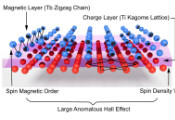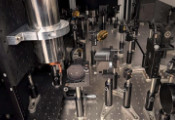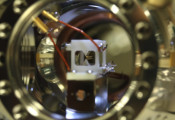Ring Resonators Unlock New Abilities in Acoustic Tweezers
November 25, 2024 -- Over the past several decades, researchers have been getting better and better at manipulating tiny particles with acoustic waves. Dubbed “acoustic tweezers,” the technology started with the simplistic trapping of particles and has since expanded to include the precise rotation and movement of cells and organisms in three dimensions.
These abilities make the technology well suited to address challenges in biological studies, medical diagnostics and therapeutics through the precise, dexterous, biocompatible manipulation of bioparticles.
In a new paper published online November 14 in the journal Science Advances, engineers from Duke University demonstrate an entirely new approach to the technology using “ring resonators.” With the ability to carry out tasks with high precision while requiring much lower power inputs, the work could inspire a new generation of these devices.
“Ring resonators are a highly sought-after topic across various fields of physics,” said Xianchen Xu, a postdoctoral researcher in the lab of Tony Jun Huang, the William Bevan Distinguished Professor of Mechanical Engineering and Materials Science. “Our work is the first to utilize ring resonators in an acoustic tweezer application, enabling manipulation of particles such as trapping, moving and mixing.“
There are many approaches to building acoustic tweezers, and they all rely on acoustic waves traveling through some sort of fluid. When traveling in opposite directions in a volume of liquid, for example, acoustic waves can sync together to form pockets of high and low pressure to trap and move particles. If traveling along a flat surface instead, they can create standing waves in a thin layer of fluid that particles essentially surf along.
All previous approaches, however, often run into a power problem. To create strong enough waves that can perform all the various tasks required, acoustic tweezers can draw too much voltage and heat up. Besides damaging the device itself, this can damage the delicate biological particles and organisms that this technology is often used for.
“In the field of acoustic tweezer research, the challenge of heating caused by the high voltage applied to transducers has received limited attention, despite its critical importance,” said Huang. “The ring resonator is an excellent solution to these challenges.”
To demonstrate their ideas, Huang, Xu and Ke Jin, a PhD student in the same laboratory, developed a prototype. Here’s how it works.
Acoustic waves are focused on each end of two channels running parallel to one another, creating a standing wave in each. Between the two channels is a ring that fits perfectly between them, barely touching edges with each. This ring only lets in a very specific frequency of acoustic wave, meaning it has an extremely high quality factor, or q-factor for short. It also resonates at this specific frequency, causing the acoustic waves that enter to compound and amplify one another.
When the acoustic waves traveling down the parallel channels match the ring’s resonant frequency, a standing wave forms along the ring that is more powerful than the original waves. This also creates standing waves in a thin layer of liquid on top of the entire device, which can trap particles of various sizes.
“At the ring resonance frequency, the acoustic wave amplitude on the ring is higher than that in the channels, meaning particles are more strongly attracted to the ring than the channels,” explained Xu. “While the channels maintain a constant acoustic wave amplitude, we can adjust the acoustic wave amplitude on the ring by changing the input frequency.”
By modulating the phase of the acoustic waves, researchers can move the standing waves around the ring resonator as well as down each of the channels, carrying along any particles in the thin layer of liquid with them. They also demonstrated that a high degree of particle mixing can be achieved where the ring meets each of the channels.
But that’s only what can be done with a single ring resonator. The researchers also show setups where two or more ring resonators with different resonate frequencies are placed next to one another. Based on the configurations, researchers can create a wide variety of complicated procedures.
“The advanced design of the ring resonator enables precise and versatile manipulation of the acoustic field, facilitating highly accurate and sophisticated functions, including liquid mixing, pumping, particle separation, and targeted particle transport,” Huang said. “This setup is also highly integrative and modular, providing a foundation for expanding the potential applications of acoustic tweezer technology in broader fields such as biology, medicine, and materials science.”




































